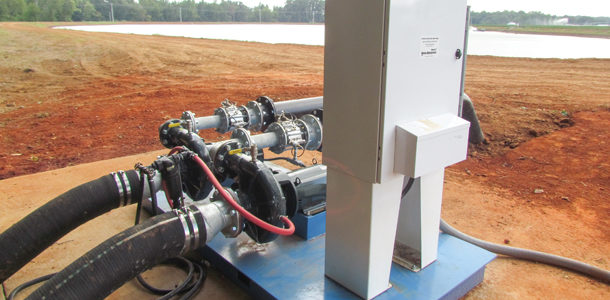Which truck would you buy? You would choose the truck that has been well-maintained; the same standards apply to maintaining pumps.
Pumps are the livelihood of your irrigation system. Without a pump, the irrigation machine is just a paperweight, and paperweights do not grow crops.
Maintaining pumps is just like maintaining your vehicle: change the oil, grease it and follow all other recommendations.
There are multiple types of pumps: centrifugal, turbine and submersible. You will only see a centrifugal pump/motor above-ground along with a turbine motor/discharge head.
The turbine pump is below-ground, as is a submersible pump/motor. Even though some pumps are underground, they still need maintenance that can be performed above-ground.
We will discuss some pump maintenance procedures here, but always refer to your owner’s manual and follow your particular pump original manufacturer equipment’s (OEM) recommended procedures.
The OEM might specify particular oils or grease to be used with your pump, so you will want to follow those guidelines.
Turbine pumps
Avoid reduced performance
You will experience reduced performance if the following are not maintained:
-
Lateral adjustment – Performance can be greatly improved if impellers are located correctly.
This should be done when pump is set, but after years of running, the lateral adjustment can change. It should be checked per the OEM’s recommendations.
-
Well conditions – Changes can occur over time, so: Check the water level and check to make sure there are no signs of air entrapment in the column pipe.
- Motor speed – Motor speed can be slowed by overload, low voltage or low frequency in lines.
Lubrication
Turbine pumps can either be water-lubricated or oil-lubricated.
Water lubrication essentially allows the water passing through the pump to keep it lubricated and cooled. If there is cavitation or loss of water, the pump can heat up and lock up or cause bearing damage.
Oil-lubed means that while the pump is running, there is a reservoir above-ground that will slowly drip oil down the shaft, lubricating the pump in the well. Bearings are lubricated by the oil in the frame housing.
The oil level must be maintained; check and fill it when the pump is not operating. Add oil through the pipe plug opening at the top of the housing and fill to the level indicated. Keep dirt and moisture out.
The type and grade of oil used is very important for maintenance-free operation. Follow the OEM recommendations.
Centrifugal pumps
Examine pumps at regular intervals for leakage resulting from sealing faces wear. Inspect new installations daily as they may leak temporarily. If leakage does not reduce to nearly nothing, check for proper seal installation.
If the pump does not have a mechanical seal, inspect packing. Tighten packing in stuffing boxes to reduce leakage to a trickle. Install additional packing rings or replace packing.
If adding a new packing ring to an old packing doesn’t reduce leakage, remove the old packing completely. Inspect the shaft sleeve. Installing new packing against a worn sleeve will not resolve issues.
Install a suction strainer at the suction inlet to keep unwanted solids out of the pump. Debris accumulation can induce a moderate pressure drop. If a pressure drop occurs, check the strainer for buildup.
All pumps
- Lubricate electric motor bearings with a hand-operated grease gun only.
- At the end of the season: Pump in grease until old grease is expelled from the relief plug.
- At the beginning of season: Start up motor and let it run until surplus grease is expelled.
- Follow OEM recommendations for exact frequency. Have a qualified electrician perform electrical maintenance, such as ensuring all electrical connections are secure and not vandalized, checking motor full-load amperage and ensuring it is the same as the nameplate on the motor.
- Prevent pump backspin and hydraulic shock, which can severely damage the pump and motor, by installing at least one check valve in the discharge pipe.
- Suction and discharge piping should be anchored, supported and restrained near the pump to avoid excess application of forces and moments. Pump vibration dampening will help achieve optimum operation and minimum noise and vibration.
- Check all alarm point settings and control and alarm systems. Install undercurrent relays in the power supply lines to prevent excessive drawdown.
Winter prep
Pumps (and pipes) used in the winter must be protected from freezing. Add a heater if necessary. If not used in the winter, drain the volute or any piping off the pump to prevent damage.
Maintained pumps will not only last longer but will stay more efficient as the years go on, providing you with their best performance.
As pumps get more hours on them, they will lose efficiency if they are not maintained. Lost efficiency will have a tangible effect on your pocketbook because the pump has to work harder to do the same job it did last year. Your pocketbook will take an even bigger hit if you have to prematurely replace a pump due to lack of maintenance. FG
Peerless Pump and Cornell Pump Company contributed to this article.
PHOTO
Even if you’re not a pump expert, there are some simple procedures you can perform to lengthen the life of and maintain the efficiency of your irrigation pump. Photo courtesy of Tyler Fields.
Tyler Fields
Project Sales Manager
Valley Water Management











